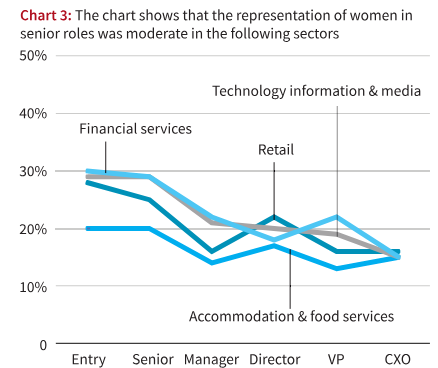Note4Students
From UPSC perspective, the following things are important :
Mains level: Women Issues;
Why in the news?
Although women’s representation in the workforce has grown over the years “LinkedIn’s Economic Graph data” indicates that progress has stalled since 2022 and declined in 2024.
What does the data show?
- Representation of women in the workforce has increased over the years but progress has stalled since 2022 and declined in 2024. The promotion of women to senior and leadership roles has stagnated in recent years.
- Sectors like healthcare, education, administrative, and support services have higher female representation in senior positions, while sectors like manufacturing, construction, oil, and gas have poor representation.
Representation of women in the overall workforce and in senior positions

Entry and career progression of women

- Oil, Gas, and Mining: Among the lowest representation of women in leadership roles, at around 11%.
- Construction: Very few women are represented, especially in senior roles.
- Utilities: Women face significant barriers in advancing to leadership positions.
- Wholesale: Low entry and career progression for women.
- Manufacturing: Poor representation of women across all positions, including senior roles.
- Transportation: Limited career progression opportunities for women.
- Real Estate: Few women in leadership positions, with significant entry barriers.
About the accommodation and other services

- Representation of women in senior roles within the accommodation and food services sector falls between 15% and 20%.
- This sector exhibits a moderate level of female representation compared to other industries.
- While not the highest, it surpasses sectors like oil, gas, mining, construction, utilities, wholesale, manufacturing, transportation, and real estate, where women hold just 11%-14% of leadership positions.
- The data suggests there’s still room for improvement in increasing the number of women in leadership roles within the accommodation and food services sector.
- Efforts to improve gender diversity and inclusion should be continued and perhaps intensified in this sector, aligning with broader industry and societal goals for gender parity in the workforce.
Administrative and support services:

- Women hold senior positions in administrative and support services at a rate of 22% to 30%, indicating a moderate level of representation compared to other sectors.
- This sector demonstrates a higher level of female representation in leadership roles compared to industries like oil, gas, mining, construction, utilities, wholesale, manufacturing, transportation, and real estate, where women’s leadership roles range from 11% to 14%.
- The education sector boasts the highest representation of women in senior positions at 30%, suggesting that sectors like administrative and support services still have room for improvement.
- Efforts to promote gender diversity and inclusion within administrative and support services should be sustained, aiming for further increases in the representation of women in leadership roles.
- Continued focus on addressing biases, societal norms, and structural barriers is essential to achieving greater gender parity and advancement opportunities for women within this sector.
Way Forward
- Efforts by policymakers and business leaders are needed to tackle challenges faced by women in reaching leadership roles, focusing on “women-led development”.
- Stricter enforcement of laws such as the Companies Act, 2013, which mandates women directors on company boards. Between April 2018 and December 2023, 507 companies were fined for non-compliance, with 90% being listed companies.
Mains PYQ
Q Micro-Finance as an anti-poverty vaccine, is aimed at asset creation and income security of the rural poor in India”. Evaluate the role of the Self Help Groups in achieving the twin objectives of empowering women in rural India. (UPSC IAS/2020)
Get an IAS/IPS ranker as your 1: 1 personal mentor for UPSC 2024
